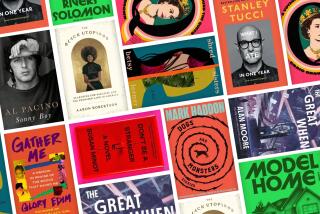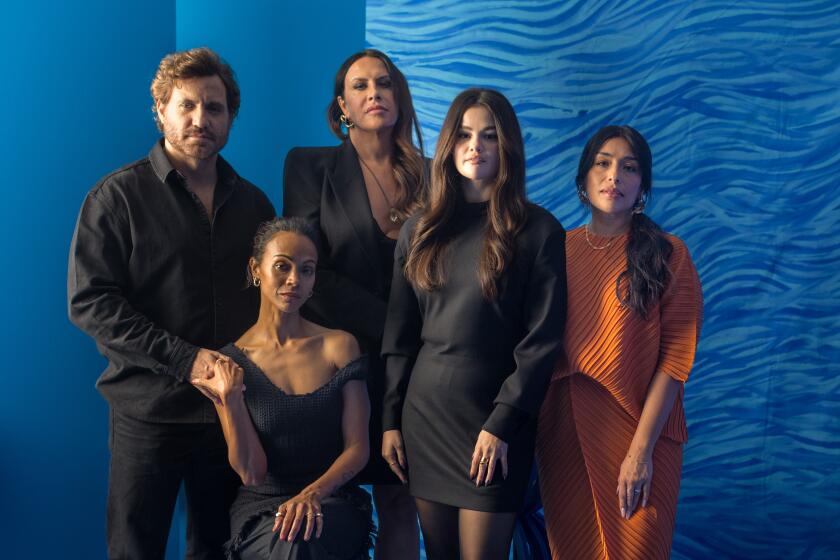You know it’s noir ...
NEAR the end of “Hollywoodland,” we see what purports to be a black-and-white home movie of former TV Superman George Reeves (played by Ben Affleck) doing stunts on his lawn. He’s down and out, auditioning as a wrestler now that his acting career has gone flat. It’s a tragic moment, full of loss and degradation -- and a perfect evocation of noir.
Noir tells us that it’s a hard life, that even success has its flip side, that we lose more often than we win. And as “Hollywoodland,” which opens Friday, amply demonstrates, what better noir landscape could there be than Hollywood, fueled as it is by equal parts desperation and desire? Reeves, who played Superman on television, died in 1959 under mysterious circumstances, and the film, with its evocation of 1950s Los Angeles, its detective protagonist and its overarching moral ambiguity, is also fittingly noir.
Noir, after all, is not just style but substance, a way of seeing the world. It tells us that there’s more to things than what we’re seeing, that the official story is never enough. This is the lesson of “The Black Dahlia,” as well, the upcoming Brian De Palma movie based on James Ellroy’s 1987 neo-noir novel, which has its roots in one of L.A.’s most infamous murders -- the kind of story that tantalizes us by seeming not only unresolved but irresolvable. At one point in “The Black Dahlia,” a Los Angeles cop named Bucky Bleichert reflects that “Nothing stays buried forever. Nothing.” It’s a bit of wisdom dredged from the depths of the hard-boiled universe, and it sums up the appeal of noir.
Noir is one of those catch-all designations, an I-know-it-when-I-see-it concept as elusive as a Santa Ana wind. It’s an American genre with a French name, a literary style perhaps best understood in terms of movies: stylized and atmospheric, black and white.
As a literary form, noir got its start in the 1920s, with the writers who contributed to the pulp magazine Black Mask. These included Raymond Chandler, Dashiell Hammett -- his “Red Harvest,” published in 1929, is generally considered the first hard-boiled novel -- and the now-forgotten Paul Cain, whose 1933 novel “Fast One” brought noir to L.A.
In 1934 and 1935, James M. Cain published, back to back, “The Postman Always Rings Twice” and “Double Indemnity” -- perhaps the two greatest noir novels of all. Horace McCoy portrayed murder as an act of compassion in “They Shoot Horses, Don’t They?” (1935), set against the backdrop of a Santa Monica dance marathon.
What these books share is a sense of the world as lost, desperate, a place where bad things happen, where people are taken advantage of, or worse, take advantage of themselves. By 1939, when Chandler published his first novel, “The Big Sleep,” noir (although not yet called that) had become part of the popular imagination, an anti-myth evoking the darkness, the desolation, that lay just beneath the rosy surfaces of American life.
In many ways, this was a reaction to the Depression, which marks early noir like a brand. It was a treacherous time, one in which gangsters became folk heroes -- John Dillinger, Bonnie and Clyde. Edward Anderson’s 1937 novel “Thieves Like Us” takes on this type of figure, a bank robber who pursues crime reluctantly, even as his outlaw legend grows. In “You Play the Black and the Red Comes Up,” Eric Knight (better known as the author of “Lassie Come Home”) puts another spin on the era, describing a man who follows his wayward wife to California only to fall into an empty, peripatetic life.
The situation is reminiscent of John Fante’s 1939 novel “Ask the Dust,” which describes an equivalent set of circumstances. That book may seem like a noir anomaly, but in fact, it’s a symbol of how far the genre goes. A literary novel, it nonetheless shares something fundamental with hard-boiled fiction: a flatness, a lack of affect, a knowing cynicism about the disappointments of the world.
“Dust and old buildings and old people sitting at windows,” Fante writes, “old people tottering out of doors, old people moving painfully along the dark street. The old folk from Indiana and Iowa and Illinois, from Boston and Kansas City and Des Moines, they sold their homes and their stores, and they came here by train and by automobile to the land of sunshine, to die in the sun, with just enough money to live until the sun killed them, tore themselves out by the roots in their last days, deserted the smug prosperity of Kansas City and Chicago and Peoria to find a place in the sun.”
The same is true of Nathanael West’s “The Day of the Locust,” with its riot of the disaffected out on Hollywood Boulevard, its motif of “The Burning of Los Angeles” -- a vision of the city as dystopian nightmare landscape, a place people come to die. Here we have the underside of the California dream, and it seems particularly appropriate to Los Angeles, with its outsized fantasies of celebrity, its abiding myth of reinvention, the idea that this is where we may finally escape ourselves. “The future always looks good in the golden land,” Joan Didion has written, “because no one remembers the past.”
Yet what do we do when the past comes calling, when all the things we thought we left behind us (bad family, bad relationships, bad credit, bad luck) return to haunt us at continent’s end? That’s noir in a nutshell: the desperate sense that this is the final hand, the last card, that there is nowhere else to turn. Noir reveals, to borrow a phrase from Didion, “how close to the edge we are.”
Didion, of course, was writing about a different California, the California of the 1960s; she hasn’t lived in Los Angeles in almost 20 years. Still, the sensibility remains relevant, perhaps more now than before. Secret shame, corruption in high places, cynicism, double standards: These are not features of California life only. We find them everywhere, from the JonBenet Ramsey case (another unsolved murder) to the Enron scandal, from Katrina to Iraq.
Little wonder, then, that noir inspires writers like Ellroy -- whose books are equally homage and update -- as well as James Sallis, George Pelecanos, Michael Connelly. Walter Mosley has turned noir into high art with his Easy Rawlins novels, which use genre conventions to frame a social history of African American life in L.A.
Then, of course, there’s Hollywood, and the hard-boiled school of writing it spawned. It’s no coincidence that “I Should Have Stayed Home” -- the darkest Hollywood novel ever -- was written by McCoy. Chandler, too, produced a Hollywood novel, “The Little Sister,” and noir infuses Carroll and Garrett Graham’s “Queer People,” Gavin Lambert’s “The Slide Area” and Budd Schulberg’s “What Makes Sammy Run?”
This is what “Hollywoodland” gets at, Hollywood as a kind of apex of the genre. Even Superman is not immune to the disappointment and despair lurking in all of our lives. (“The Black Dahlia” traffics in that also, but being Ellroy, or an Ellroy spinoff, it’s more of a tawdry hustle, a fantasy of stag films and one-night stands.)
Bleak? Yes. Sobering? Certainly. But ultimately, it’s truer than a happy ending, which is why noir continues to move us even now.
More to Read
Only good movies
Get the Indie Focus newsletter, Mark Olsen's weekly guide to the world of cinema.
You may occasionally receive promotional content from the Los Angeles Times.











